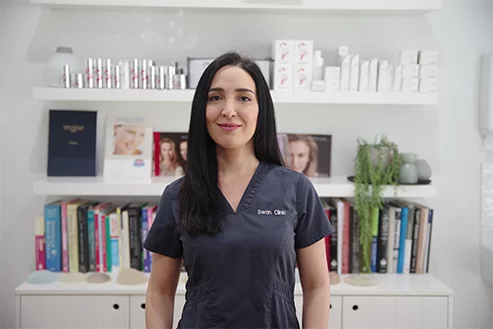Autologous fat graft to the breasts
An alternative option for increasing breast size is autologous fat grafting, which involves transferring fat from another area of the body to the breast. While this procedure does not involve implants, it carries its own potential risks and limitations, including fat resorption, calcification, or the need for multiple sessions to achieve the desired volume.
What Is Breast Augmentation With Fat Graft?
Breast augmentation using fat grafting is a surgical procedure that involves using your own fat cells to increase breast volume. This technique may be considered for individuals seeking a modest increase in breast size or to restore volume lost due to factors such as weight fluctuations, breastfeeding, or age-related changes.
How the Procedure Works
Fat is harvested from one or more areas of the body where excess fat is present. Common donor sites include:
- Lower or upper abdomen
- Flanks
- Inner or outer thighs
The fat is removed through liposuction using a fine cannula, typically through small incisions. The harvested fat is then processed to prepare it for transfer. It is carefully injected into the breast tissue using small amounts (often described as micro-ribbons) to support integration and promote a blood supply to the transferred cells.
Fat Survival and Volume Retention
Scientific studies have shown that fat grafting can have a long-term survival rate, with fat retention varying from approximately 50% to 80%. Outcomes may vary between individuals based on factors such as body type, lifestyle, and surgical technique.
Typically, one session of fat grafting may result in an increase of about one cup size, although this can differ based on individual anatomy and goals. Additional sessions may be needed to achieve the desired result.
Considerations and Potential Benefits of Fat Grafting
- Uses your own tissue, which may be preferred by some patients over implants
- The fat is harvested via liposuction, which may improve the appearance of the donor area
- Can be performed in stages or repeated if additional volume is desired
- Published studies suggest a long-term fat retention rate of approximately 50% to 80%
- Some components of the fat, including plasma and other cellular material, are transferred along with the fat cells; however, the role of these components in tissue regeneration is still being studied
- Avoids the use of implants and their associated risks
Potential Risks of Fat Grafting
As with any surgical procedure, breast augmentation via fat graft carries risks, including general surgical risks as well as those specific to fat grafting:
- Infection at the donor or recipient sites, which may require antibiotics or further treatment
- Bruising and swelling at both donor and recipient areas, which are common and usually temporary
- Asymmetry or unevenness in breast size or shape after fat transfer
- Irregularities such as lumps, firmness, or contour changes in the treated areas
- Partial fat loss, as some transferred fat may not survive, affecting volume or shape
- Fat necrosis, where small areas of fat harden or form cyst-like lumps
- Oil cysts, fluid-filled pockets that can develop where fat cells break down
- Changes in sensation, including numbness or altered sensitivity in donor or recipient sites
- Scarring at liposuction donor sites, typically small but variable depending on healing
- Seroma formation (fluid accumulation), which may require drainage
- Need for additional procedures to achieve desired volume or correct asymmetry
- Calcifications in the breast tissue, which may be visible on imaging such as mammograms
- Anaesthesia-related risks, including allergic reactions or respiratory complications
Recovery and Aftercare – Fat Grafting
- Swelling and bruising are common at both donor and recipient sites and usually improve over several weeks
- Mild to moderate discomfort or tenderness may be experienced and is typically managed with prescribed or over-the-counter pain relief
- Compression garments may be recommended for the donor area (such as abdomen or thighs) to reduce swelling and support healing
- Ice packs may be advised in the early post-operative period to reduce swelling at the recipient site (if directed by your surgeon)
- Sleeping position may need adjustment to avoid pressure on the grafted area, especially if fat has been transferred to the buttocks or breasts
- Strenuous activity and exercise should be avoided for at least 4-6 weeks, or as advised by your surgeon
- Some volume loss is expected as not all transferred fat will survive; results will be monitored during follow-up
- Smoking and alcohol should be avoided during recovery, as they may affect fat survival and wound healing
- Final results may take several months to stabilise as swelling resolves and the fat graft settles
- Follow-up appointments are important to assess healing and discuss whether additional treatments may be appropriate
FAQs
How long will the operation take?
The operation will take around 2 hours plus recovery time and is performed under general anaesthetic. This procedure is performed at the Swan Clinic or in hospital.
How long will I stay in the hospital?
The surgery is usually performed as day surgery or overnight stay.
Do I need to wear a post-operative garment?
You'll be provided with a garment depending on the doner site which you will wear for 6 weeks. Do not wear a bra for 6 weeks postoperatively, we do not want to compress the fat.
Are my sutures dissolvable?
Dissolvable sutures are used to close the small incisions.
When can I shower?
You can shower 2 days post operatively.
When can I drive? When can I exercise?
Do not drive for 24hrs after a general anaesthetic. You can drive once comfortable, generally after one week. Gentle walking after 2 weeks and return to exercise at 4-6 weeks.
When can I go back to work?
Depending on your work's physical demands, take 1-2 weeks off before returning to work.

